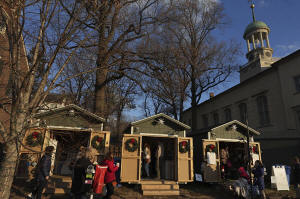Pennsylvania's Bethlehem: The city founded by Moravians on Christmas eve
keeps its traditions alive
 Send a link to a friend
Send a link to a friend
 [December 18, 2024]
By LUIS ANDRES HENAO [December 18, 2024]
By LUIS ANDRES HENAO
BETHLEHEM, Pa. (AP) — On Christmas Eve in 1741, Moravian settlers named
this Pennsylvania city after the biblical birthplace of Jesus. Nearly
300 years later, Moravians continue celebrating their Christmas season
traditions in Bethlehem.
They include the “putz,” a Nativity scene that tells the story of
Christ’s birth with miniature wooden figurines, the making of thousands
of beeswax candles by hand as a symbol of the light that Jesus brought
to the world and a “lovefeast,” a song service where worshippers share a
simple meal of sweet buns and coffee in their pews.
“Like all Moravian traditions, the importance of it is that it brings
people together,” said the Rev. Janel Rice, senior pastor of Central
Moravian Church — Bethlehem’s first congregation and the oldest Moravian
church in North America.
“Building community, emphasizing that, over doctrine or dogma, is really
the Moravian practice and tradition at our core," she said.
Moravians relate to the story of Jesus, Mary and Joseph, Rice said,
because their ancestors began as a refugee church fleeing religious
persecution. The Nativity is also a poignant reminder today, when the
number of people fleeing their homes because of war, violence and
persecution continues to rise worldwide.

“It’s so crucial because this story is not just Jesus’s story of 2,000
years ago. It’s today’s story. And we need to make sure that we're
living the word that we were told when it comes to these refugees,” said
church member Sarah Wascura. “That word is to give them refuge and to
take care of them and to love them as ourselves.”
A town founded on Christmas Eve
The Moravian Church is one of the world's oldest Protestant
denominations. Its name comes from the historical provinces of Bohemia
and Moravia in what is now the Czech Republic.
Their beliefs of practice over dogma began with a religious reformer,
John Hus, who led a protest movement against some of the practices of
Roman Catholic hierarchy. Hus believed congregants in his church should
listen to Mass and read the Bible in their native Czech instead of
Latin. He was accused of heresy and burned at the stake in 1415.
His ideas were carried on by his supporters, who broke with Rome and
founded the Moravian Church, or Unitas Fratrum (Unity of Brethren) in
1457 — decades before Martin Luther’s Protestant Reformation.
Moravians facing persecution eventually fled to Herrnhut, Germany, and
established the original Renewed Moravian Church settlement, according
to accounts of church history.
Moravian missionaries later settled in Pennsylvania.
On Christmas Eve in 1741, their leader, Count Nicolas Ludwig von
Zinzendorf, who was visiting them, led them to a stable, where they sang
the hymn “Jesus Call Thou Me.” Its lyrics say: “Not Jerusalem — lowly
Bethlehem 'twas that gave us Christ to save us.” Thus inspired,
Zinzendorf named the settlement Bethlehem.
A beloved tradition retells the story of the birth of Jesus
Bethlehem’s first settlers brought with them hand-carved figures to
retell the story of Christ's birth. The tradition is known as the putz,
from the German word “putzen,” meaning to clean or decorate.

“It relates back to the creches of the Middle Ages,” Rice said. “But
it’s not just a creche, which would be just the one Nativity scene.”
Instead, it uses figures to tell different parts of the Gospel in
miniature, including Mary’s annunciation and the visit of the three wise
men to the infant Jesus.
In Victorian days, Rice said, Bethlehem’s residents would “go putzing” —
visiting each other’s homes between Christmas Eve and New Year’s Day to
look at Nativity scenes.
In 1937, the local chamber of commerce launched a campaign promoting
Bethlehem as “Christmas City USA.” As part of that promotion, they took
the tradition of the putz to the historic Hotel Bethlehem on Main
Street. Thousands turned up.
“The story goes that the hotel got so crowded that they couldn’t really
accommodate the number of people that were coming to see it, and they
asked Central Moravian Church to host it.”
[to top of second column]
|

People shop at Christmas-themed wooden huts located next to the
Central Moravian Church in Bethlehem, Pa., on Sunday, Dec. 1, 2024.
(AP Photo/Luis Andres Henao)
 For every Christmas since then, the
community putz has been put together by the church’s congregants and
displayed at the nearby Christian education building.
“It’s more than Christmas for four weeks a year,” said Wascura, who
went to the putz on her first date with Bob Wascura, her husband of
33 years.
“The nature of the faith heritage of the city is something that is
never forgotten.”
On a recent day, she led families visiting the community putz to
their seats. After recounting a brief history of the Moravian Church
and the Pennsylvania city, she drew a curtain to display the dozens
of wooden figures — angels, shepherds, kings carrying gifts — in a
tiny landscape decorated with pebbles, wood and moss.
Children and parents listened to the recorded voice of Janel Rice,
who narrated the biblical story about the other Bethlehem.
“We might wonder why setting up a putz and telling the story of
Jesus’ birth is so important to the Moravians, and now to the city
of Bethlehem,” Rice says in the recording. “One reason has to do
with the naming of the city itself.”
The church choir, after some singing, gave way to the powerful sound
of the renowned Moravian Trombone Choir, known for playing its
brassy tunes from the belfry of Central Moravian Church. When the
lights turned on, children approached the stage to look up close at
the figurines and point at surprises near the manger, including
miniature zebras, lions and giraffes.
“We feel really lucky to live so close to Bethlehem with all of the
history here and specifically the history pertaining to Christmas,"
said visitor Kelly Ann Ryan. “It’s just something that we can’t miss
every holiday season as it rolls around.”
She came to Bethlehem from a nearby town with her husband, Daniel,
and their 5- and 8-year-old sons to see the community putz, in what
she said has become a family tradition.

“Telling the Christmas story this way is a great way for kids to
connect with it.”
Lighting candles on Christmas Eve, joining Santa for a sleigh
ride
Christmas — from the Christian celebration to the secular commercial
holiday — is omnipresent in Bethlehem.
On a recent day, Santa Claus checked on a red sleigh (drawn by
horses instead of reindeer) outside Central Moravian before he led
families who hopped on for a tour of Bethlehem and its Moravian
church settlements, which were recently designated by UNESCO as a
World Heritage Site.
Others strolled to nearby holiday-themed wooden huts or along Main
Street with its stores decorated with Christmas globes and Moravian
stars. Some stopped outside an Italian restaurant to greet Santa and
Mrs. Claus, who welcomed diners and posed for photos.
Across town, vendors sold ornaments at Christkindlmarkt, in the
shadow of rusting blast furnaces of Bethlehem Steel illuminated in
red and green. That company once supplied steel for construction of
the Empire State Building, the Golden Gate Bridge and other
landmarks.
At Central Moravian, the choir sang hymns while sacristans handed
out buns and mugs of coffee to families who enjoyed the sustenance
in their pews at the “lovefeast.”
After Rice delivered a final blessing, Linda Thudium walked up the
stairs and opened a large closet, where the congregation keeps
thousands of handmade candles wrapped in red ribbons that they light
during Christmas services.
“To me, this is Christmas — looking at these candles,” said Thudium.
She recalled attending Christmas Eve services with lit candles since
she was 5, a tradition she continued with her children and
grandchildren.
“To me, this is just magical. I remember my parents doing this, my
grandparents," she said. "It’s just a wonderful warm feeling of
being connected with this church.”
All contents © copyright 2024 Associated Press. All rights reserved
 |